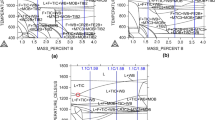Abstract
Fatigue-resistance characteristics of Ti–6Al–4V alloy synthesized by the simplest powder metallurgy method involving the processes of pressing and sintering of blended elemental titanium hydride-based powders were studied. Powder materials have a relatively fine-grain β-phase, which despite the presence of residual pores, makes for quite a high fatigue limit (500 MPa) comparable to that of the corresponding cast alloys. Fatigue cracks in the powder alloys are initiated from such stress raisers as major pores open to the surface of the specimen gauge length. Along with a significant decrease in the production costs of titanium alloys and articles of them, the use of this method provides obtaining materials with satisfactory static and dynamic mechanical characteristics suitable for practical applications.
Similar content being viewed by others
REFERENCES
F. H. Froes and D. Eylon, "Powder metallurgy of titanium alloys-a review," in: F. H. Froes, D. Eylon, and H. B. Bomberger (Eds.), Titanium Technology: Present Status and Future Trends, Warrendale (1985), pp. 49–59.
M. Hagivara, Y. Kaieda, Y. Kawade, and S. Miura, "Property enhancement of α?-β?-?titanium alloys by blended elemental P/M method," in: Titanium 92, Science and Technology: Proc. 7 World Conf. on Titanium, Warrendale (1993), 1, pp. 887–894.
H. Fujii, K. Takahashi, K. Fujisawa, et al., "Low cost process of blended elemental powder metallurgy," in: Titanium 95, Science and Technology: Proc. 8 World Conf. on Titanium, London (1996), 1, pp. 2547–2554.
S. Abkowits and D. Rowell, "Superior fatigue properties for blended elemental P/M Ti-6Al-4V," J. Met., Aug., 36–39 (1986).
F. H. Froes, C. M. Cooke, D. Eylon, et al., "Grain growth in blended elemental Ti-6Al-4V powder compacts," in: Proc. 6 World Conf. on Titanium, Paris (1989), pp. 1161–1166.
O. M. Ivasishin, A. N. Demidik, and D. G. Savvakin, "Phase transformations on synthesis of titanium aluminides from TiH2 and Al powders," in: Titanium 95, Science and Technology: Proc. 8 World Conf. on Titanium, London (1996), 1, 440–447.
O. M. Ivasishin, V. M. Anokhin, A. N. Demidik, and D. G. Savvakin, "Cost-effective blended elemental powder metallurgy of titanium alloys for transport application," Key Eng. Materials, 188, 55–62 (2000).
O. M. Ivasishin, D. G. Savvakin, K. A. Bondareva, et al., "Synthesis of Ti-6Al-4V alloy with a low residual porosity by powder metallurgy," Poroshk. Metallurg., No. 7-8, 54-64 (2002).
O. M. Ivasishin, D. G. Savvakin, V. S. Moxson, et al. "Titanium powder metallurgy for automotive components," Materials Techn. & Adv. Perform. Materials, 17, No. 1., 20–25 (2002).
V. T. Troshchenko, B. A. Gryaznov, O. N. Gerasimchuk, et al., "Fatigue resistance and cyclic fracture toughness of VT3-1 titanium alloy in various structural states. Part 1. Experimental procedure and test results," Probl. Prochn., Nos. 5-6, 3–11 (1995).
V. T. Troshchenko, B. A. Gryaznov, O. N. Gerasimchuk, et al., "Fatigue resistance and cyclic fracture toughness of VT3-1 titanium alloy in various structural states. Part 2. Method to account for the effect of structure on the fatigue limit," Probl. Prochn., Nos. 5-6, 12–17 (1995).
J. Lindemann, A. Berg, and L. Wagner, "HCF-behavior of TIMETAL 1100: Fully lamellar vs. duplex microstructures," in: Titanium 95, Science and Technology: Proc. 8 World Conf. on Titanium, London (1996), 2, 1187–1194.
O. M. Ivasishin, P. E. Markovskii, O. N. Gerasimchuk, et al., "Effect of thermomechanical treatment on the fatigue resistance of VT3-1 titanium alloy," Probl. Prochn., No. 6, 12–19 (1992).
V. A. Boguslaev, O. M. Ivasishin, O. N. Gerasimchuk, et al., "Optimization of physicomechanical properties of structural and high-temperature titanium alloys by way of regulation of thermomechanical and thermal treatment conditions," in: Abstr. Vth Sci. Conf. New Structural Steels and Alloys and Methods of Treating Them to Improve Reliability and Extend the Life of Their Products, Zaporozh'e (1992), p. 92.
P. K. Liaw, T. R. Leax, and W. A. Logston, "Near threshold fatigue crack growth behavior in metals," Acta Met., 31, No. 10, 1581–1587 (1983).
V. T. Troshchenko, V. V. Pokrovskii, V. Yu. Podkol'zin, and P. V. Yasnii, "Influence of the loading cycle asymmetry and characteristics of strength on the cyclic crack growth resistance of structural alloys with regard for the effect of crack closure," Probl. Prochn., No. 10, 17–25 (1991).
V. T. Troshchenko, "Investigation of threshold stress intensity factors for cyclically-loaded materials. Part 2. Prediction of fatigue limits and fatigue crack development," Probl. Prochn., No. 5, 5-11 (1998).
Author information
Authors and Affiliations
Rights and permissions
About this article
Cite this article
Ivasishin, O.M., Bondareva, K.A., Bondarchuk, V.I. et al. Fatigue Resistance of Powder Metallurgy Ti–6Al–4V Alloy. Strength of Materials 36, 225–230 (2004). https://doi.org/10.1023/B:STOM.0000035756.11562.c3
Issue Date:
DOI: https://doi.org/10.1023/B:STOM.0000035756.11562.c3




